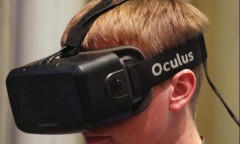By Lynn Palec, | March 28, 2016

An undated handout photo of Microsoft's HoloLens, a holographic lens device that allows users to see three-dimensional renderings of computer-generated images.
Tech giant Microsoft recently revealed some new features for its flagship augmented reality headset HoloLens. The latest feature is called "Holoportation" and it allows HoloLens users to project a live hologram of another person which can be rendered even in a separate room.
The Microsoft HoloLens team working on the project claims that they were able to achieve Holoportation by using massive array of 3D cameras which can capture the subject's movements as well as speech in real time
Like Us on Facebook
The hologram which is created by this array of 3D cameras can then be projected into a separate room where the subject is not physically present. People on that room with a HoloLens headset can not only see the subject hologram but can also interact with them.
It been more than a year since Microsoft first demonstrated the augmented reality features of the HoloLens. There are also a handful of indications pointing to a possibility of a consumer edition of the headset which could be released sooner than originally expected.
While the new Holoportation feature opens up a lot of possible application for the future of augmented reality, tech experts claim that the HoloLens is far from being considered as a consumer product right now. Experts believe that a significant amount of hardware is needed in order to make this feature into a reality and not to mention the immense amount of computing power needed in order to properly render the holograms, according to Ubergizmo.
The biggest issue right now regarding the HoloLens is its price tag. A developer edition of the augmented reality devices costs $3,000, according to The Verge. On top of that, users must also build a powerful computer in order to properly handle the graphical and computing demands of the headset. Tech analysts believe that a decent computer that can handle the specs required by the HoloLens should cost at least $1,500.
These features, along with augmented reality, will need more time for development until a solution can be made in order for it to suit for mass market distribution. Nonetheless, the latest features unveiled by Microsoft are a good sign for what the future has in store of augmented reality.
-
Use of Coronavirus Pandemic Drones Raises Privacy Concerns: Drones Spread Fear, Local Officials Say

-
Coronavirus Hampers The Delivery Of Lockheed Martin F-35 Stealth Fighters For 2020

-
Instagram Speeds Up Plans to Add Account Memorialization Feature Due to COVID-19 Deaths

-
NASA: Perseverance Plans to Bring 'Mars Rock' to Earth in 2031

-
600 Dead And 3,000 In The Hospital as Iranians Believed Drinking High-Concentrations of Alcohol Can Cure The Coronavirus

-
600 Dead And 3,000 In The Hospital as Iranians Believed Drinking High-Concentrations of Alcohol Can Cure The Coronavirus

-
COVID-19: Doctors, Nurses Use Virtual Reality to Learn New Skills in Treating Coronavirus Patients











